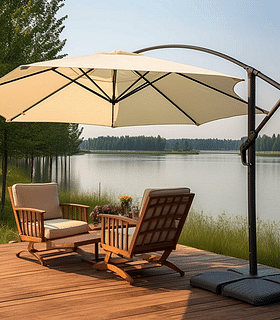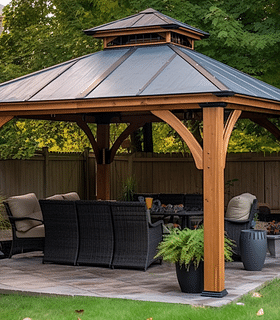How to Fix Sagging Patio Chairs - Quick and Easy Solutions
Fix your sagging patio chairs with these quick and easy solutions. Bring new life and comfort to your outdoor space. Explore our step-by-step guide now!

Have you ever sat down on your patio chair, only to sink lower and lower until you're practically sitting on the ground? It can be quite a frustrating experience, not to mention uncomfortable. Sagging patio chairs are a common problem that many homeowners face, but the good news is that there are quick and easy solutions to fix them. In this blog post, we will walk you through some simple steps to bring your sagging patio chairs back to life. Whether it's a broken frame, worn-out fabric, or loose screws causing the sagging, we've got you covered. So let's get started and get those patio chairs back to their former glory!
Understanding the Causes of Sagging Patio Chairs
Have you ever sat down on your patio chair, only to sink lower and lower until you felt like you were practically sitting on the ground? If so, you're not alone. Sagging patio chairs are a common problem that many homeowners face. But what exactly causes these chairs to sag, and is there anything you can do to prevent it? In this section, we'll explore the common causes of sagging patio chairs and how weather conditions and the chair's material can affect its structural integrity.
What are the common causes of sagging patio chairs?
There are several factors that can contribute to the sagging of patio chairs. One common cause is the natural wear and tear that occurs over time. The constant pressure applied to the seat and back of the chair can cause the material to stretch and lose its shape, resulting in sagging. Another common cause is improper maintenance. If you don't regularly clean and protect your patio chairs, they can become susceptible to damage from the elements, leading to sagging.
How do weather conditions affect the sagging of patio chairs?
Weather conditions can play a significant role in the sagging of patio chairs. Exposure to sunlight and extreme heat can cause the material of the chair to become brittle and weak, making it more prone to sagging. On the other hand, excessive moisture from rain and humidity can lead to mold and rot, which can also weaken the structure of the chair and result in sagging.
Is the material of the chair responsible for the sagging?
The material of the chair can indeed be a contributing factor to its sagging. Different materials have varying levels of durability and resiliency. For example, patio chairs made from cheap or low-quality materials may sag more quickly than chairs made from higher-quality materials. Additionally, certain materials, such as fabric or vinyl, may be more prone to stretching and losing their shape over time, leading to sagging.
In conclusion, sagging patio chairs can be caused by a combination of factors including wear and tear, lack of proper maintenance, weather conditions, and the material of the chair itself. Understanding these causes can help you take proactive steps to prevent or minimize sagging, ensuring that your patio chairs stay comfortable and supportive for years to come.
Assessing the Severity of the Sagging
Sagging patio chairs can be a nuisance and make your outdoor seating experience uncomfortable. But before you take any action to fix the problem, it's important to assess the severity of the sagging. This will help you determine the best course of action to restore your patio chairs to their original comfort.
How to determine if your patio chairs are sagging?
To determine if your patio chairs are sagging, there are a few key factors to consider:
Visual Inspection: Take a close look at your patio chairs and check if they appear lower or uneven compared to when you first bought them. Look for any visible signs of sagging, such as visible deformations or misalignments in the frame or seat.
Sitting Experience: Sit on the chair and pay attention to how it feels. Is it noticeably lower or uneven compared to when it was new? Does it provide the same level of support and comfort as before? If you feel like you're sinking too far into the chair or if it feels wobbly or unstable, it's likely that your chair is sagging.
Level Comparison: Compare the level of the sagging chair to the other chairs in your patio set. If there is a stark difference in height or overall levelness between the sagging chair and the others, then it's a clear sign that the chair is sagging.
What are the signs of severe sagging?
While minor sagging may not be too concerning, severe sagging can significantly impact the comfort and usability of your patio chairs. Here are some signs to look out for that indicate severe sagging:
Excessive sinking: If you sit on the chair and find yourself sinking too far into it, to the point where it feels like you're sitting on the frame rather than the seat cushion, this indicates severe sagging.
Structural damage: Look for any visible signs of structural damage, such as broken or bent frame components, loose or detached joints, or torn or sagging seat fabric. These are clear indications that your chair is experiencing severe sagging.
Lack of support: Severe sagging can result in a lack of support, causing discomfort and potential safety hazards when using the chair. If the chair feels unstable, wobbly, or unable to hold your weight properly, it's a sign of severe sagging.
By assessing the severity of the sagging in your patio chairs, you can determine whether simple repairs or replacement is necessary. Taking prompt action will help restore the comfort and longevity of your outdoor seating and ensure a more enjoyable experience for you and your guests.
Quick Fixes for Sagging Patio Chairs
Is your patio chair starting to sag? Don't worry, there are a few quick fixes that can help you restore its comfort and stability. In this section, we will explore some easy solutions to common issues. Let's get started!
How to tighten loose screws and bolts?
One common cause of sagging in patio chairs is loose screws and bolts. Over time, these fasteners can become loose due to regular use and exposure to the elements. To tighten them, you will need a screwdriver or a wrench, depending on the type of fastener used.
Start by examining the chair to identify any loose screws or bolts. Look for signs of wobbling or instability.
Use the appropriate tool to tighten the loose fasteners. Turn them clockwise until they are secure. Be careful not to overtighten, as this can strip the threads or damage the chair frame.
After tightening all the loose screws and bolts, test the chair for stability. Sit on it and check if the sagging has improved. If necessary, repeat the process for any remaining loose fasteners.
By tightening loose screws and bolts, you can eliminate wobbling and restore stability to your sagging patio chair.
Can adding more padding to the seat and back help?
Another quick fix for sagging patio chairs is to add more padding to the seat and back. Over time, the original padding may become worn out or compressed, leading to sagging and discomfort. By adding extra cushioning, you can restore the chair's support and improve its comfort.
Here's how you can accomplish this:
Start by measuring the dimensions of the seat and back of your patio chair. This will help you determine the size and amount of padding you will need.
Purchase foam or cushion inserts that are designed for outdoor use. Opt for materials that are water-resistant and resistant to mold and mildew.
Place the padding on the seat and back of the chair, making sure they align with the dimensions of the chair. You can secure the padding in place using adhesive or by attaching it with ties or straps.
Test the chair by sitting on it and see if the sagging has improved. You should feel a difference in the support and comfort of the chair.
Adding more padding to your patio chair can provide an immediate fix for sagging and enhance your sitting experience.
What are the benefits of using furniture webbing or straps?
If your patio chair has significant sagging issues, you may consider using furniture webbing or straps as a more robust solution. These materials are designed to provide additional support and reinforcement to sagging furniture. Here are some benefits of using furniture webbing or straps:
Enhanced support: Furniture webbing or straps can help distribute weight evenly across the chair, reducing pressure points and preventing further sagging.
Increased durability: By reinforcing the structure of the chair, webbing or straps can extend its lifespan, ensuring that it remains sturdy and reliable for years to come.
Easy installation: Webbing or straps can be easily attached to the frame of the chair using screws or staples. With a few simple steps, you can significantly improve the structural integrity of your sagging patio chair.
Versatility: Furniture webbing or straps come in various materials and widths, allowing you to choose the option that best suits your needs and preferences. They can be used for both seat and back support, providing comprehensive reinforcement.
By incorporating furniture webbing or straps into your patio chair, you can achieve long-lasting support, stability, and comfort for your outdoor seating.
Intermediate Solutions for Sagging Patio Chairs
If you've tried the quick fixes for your sagging patio chairs but are still experiencing discomfort, don't worry! There are some intermediate solutions that can help reinforce your chair and provide long-lasting support. In this section, we will discuss three effective solutions: reinforcing the seat with plywood, replacing worn-out springs, and repairing or replacing the support frame.
How can you reinforce the seat with plywood?
One effective way to add extra support to your sagging patio chair is by reinforcing the seat with plywood. This method is relatively simple and can significantly improve the overall stability of the chair. Here's how you can do it:
Start by flipping the chair upside down to access the underside of the seat.
Measure the dimensions of the seat and cut a piece of plywood to fit the size accurately. It's recommended to use a plywood thickness of at least ½ inch for optimal reinforcement.
Place the plywood on the underside of the seat, aligning it with the edges. Make sure it is centered and covers the entire surface area of the seat.
Secure the plywood in place by using screws or nails. Make sure to use screws or nails that are appropriate for outdoor use to prevent rusting or corrosion.
Once the plywood is securely fastened, flip the chair back to its upright position and test for improved support and stability. You should notice a significant difference in the firmness of the seat.
What are the steps to replace the worn-out springs?
Over time, the springs in patio chairs can wear out or become weak, leading to sagging and discomfort. If you suspect that worn-out springs are the cause of your chair's sagging, replacing them can be a viable solution. Here are the steps you can follow to replace the worn-out springs:
First, flip the chair upside down to access the underside.
Inspect the springs, and if you notice any signs of damage or wear, it's time to replace them. Measure the length and type of springs you'll need as replacements. It's best to purchase replacement springs that are specifically designed for patio chairs.
Remove the old springs by detaching them from the chair frame. This may require unscrewing or unclipping them, depending on the chair's design.
Install the new springs by attaching them to the chair frame using the appropriate screws or clips. Make sure they are properly aligned and securely fastened.
Once all the springs are in place, flip the chair back to its upright position and test it for improved support and comfort.
Is it possible to repair or replace the support frame?
Sometimes, the sagging issue in patio chairs is caused by a damaged or weakened support frame. If you've tried other solutions without success, it may be necessary to repair or replace the support frame. Here are a few options:
Repairing the support frame: If the damage to the support frame is minor, you may be able to repair it. This can involve reinforcing weak joints with glue or screws, replacing damaged crossbars, or patching any cracks or splits in the frame. Consult a professional or follow a detailed guide for specific repair instructions.
Replacing the support frame: In some cases, the damage to the support frame may be beyond repair or too extensive to fix. If this is the case, replacing the entire support frame can be a viable solution. Look for replacement frames that are compatible with your chair's design and dimensions. This option may require some assembly or professional help.
By reinforcing the seat with plywood, replacing worn-out springs, or repairing/replacing the support frame, you can significantly improve the support and comfort of your sagging patio chairs. Choose the solution that best suits your needs and enjoy your outdoor relaxation time without any discomfort.
Advanced Methods to Fix Sagging Patio Chairs
If you've already tried the basic methods to fix your sagging patio chairs and they haven't quite done the trick, don't worry. There are some more advanced methods you can try to bring new life and comfort to your outdoor seating. In this section, we'll explore three advanced methods that can help you get your patio chairs back in shape.
Can you replace the fabric or upholstery?
One option to fix sagging patio chairs is to replace the fabric or upholstery. This method is ideal if the chair frames are still in good condition but the fabric has become worn, torn, or saggy.
To replace the fabric or upholstery, you'll need to remove the old material and attach the new one. Start by removing any screws or fasteners that hold the fabric in place. Carefully take off the old fabric, making note of how it was positioned for reference. Once the old fabric is removed, you can cut the new fabric to size and attach it using a staple gun or fabric adhesive. Make sure to stretch the fabric tightly for a smooth and comfortable seat.
How to reweave the seat with new material?
If the webbing on your patio chair is sagging or broken, you can reweave the seat with new material. This method is suitable when the chair frames are still sturdy, and it's just the seating area that needs attention.
To reweave the seat, you'll need to remove the old webbing and replace it with new material. Start by removing any screws or fasteners that hold the webbing in place. Carefully remove the old webbing, taking note of the weaving pattern for reference. Then, cut the new material into strips and weave it through the chair frame, following the same pattern as the old webbing. Secure the ends of the new material with screws or staples, making sure it's tight and secure.
Is it worth considering professional chair repair services?
If you've tried the DIY methods and are still struggling to fix your sagging patio chairs, it might be worth considering professional chair repair services. Sometimes, a trained and experienced professional can provide the expertise and equipment needed to restore your chairs to their former glory.
Professional chair repair services can offer a range of solutions for sagging patio chairs, depending on the specific issues with your chairs. They may have specialized tools and techniques to repair or replace frame components, reweave seats, and even give your chairs a fresh coat of paint or finish.
When deciding if professional chair repair services are worth it, consider the overall condition of your chairs, your budget, and your DIY skills. It's important to weigh the cost of professional services against the value and lifespan of your patio chairs. In some cases, investing in professional repair or restoration may be a more cost-effective and long-lasting solution.
Remember, with advanced methods like fabric replacement, webbing weaving, or professional chair repair services, you have options to revive your sagging patio chairs. Choose the method that suits your needs, skills, and budget, and soon you'll be enjoying comfortable and inviting outdoor seating once again.
Preventing Future Sagging Issues
One of the best ways to ensure that your patio chairs stay in good shape for years to come is by taking preventative measures to avoid sagging issues. Regular maintenance, protecting chairs from weather damage, and following specific cleaning techniques can all help prolong the lifespan of your patio chairs.
How can regular maintenance prolong the lifespan of patio chairs?
Regular maintenance is the key to keeping your patio chairs in great condition. By taking the time to inspect and care for your chairs on a regular basis, you can prevent small problems from turning into bigger ones. Here are a few simple maintenance tasks you can do:
- Tighten any loose screws or bolts to ensure the chair is sturdy.
- Check for any signs of damage, such as cracks or splinters, and repair them promptly.
- Apply a protective finish, such as paint or sealant, to guard against moisture and UV damage.
By incorporating these simple maintenance tasks into your routine, you can significantly extend the lifespan of your patio chairs.
What are some tips for protecting chairs from weather damage?
Weather can take a toll on patio chairs, causing them to sag and deteriorate over time. However, there are steps you can take to protect your chairs from weather damage. Here are a few tips:
During periods of inclement weather, such as rain or snow, consider covering your patio chairs with waterproof furniture covers. This will help prevent moisture from seeping into the wood and causing it to sag.
If you live in an area with harsh winters, it may be beneficial to bring your patio chairs indoors or store them in a shed or garage during the colder months. This will protect them from extreme temperatures and prevent any potential damage.
Avoid placing your patio chairs directly in direct sunlight for prolonged periods. UV rays can cause the wood to fade and weaken over time. Consider positioning them in a shaded area or using an umbrella or shade sail to provide some protection.
By implementing these tips, you can safeguard your patio chairs from weather damage and keep them looking and functioning their best.
Are there any specific cleaning techniques for patio chairs?
Proper cleaning is another important aspect of preventing sagging issues and maintaining the appearance of your patio chairs. Here are a few cleaning techniques to keep in mind:
- Regularly sweep or brush off any loose dirt, leaves, or debris from your patio chairs. This will prevent particles from building up and potentially causing damage over time.
- Use a mild soap or detergent mixed with water to gently scrub the surface of your chairs. Avoid using abrasive cleaners or scrub brushes, as these can scratch the finish or damage the wood.
- Rinse the chairs thoroughly with clean water to remove any soapy residue.
- Allow the chairs to air dry completely before using them again.
By following these cleaning techniques, you can keep your patio chairs in pristine condition and prevent sagging issues caused by dirt and grime buildup.
Conclusion
In this blog post, we have explored various solutions to fix sagging patio chairs. We started by identifying common causes of sagging, such as worn-out straps or stretched fabric. We then discussed how to replace straps and tighten fabric to restore the comfort and functionality of your outdoor furniture.
Another option we explored was the use of support cushions and chair inserts. These innovative solutions provide extra support and help alleviate sagging in patio chairs. By simply inserting these cushions or inserts under the seat, you can enjoy a more comfortable seating experience.
Additionally, we discussed the importance of regular maintenance in preserving the comfort of your outdoor space. By keeping your patio chairs clean and protecting them from harsh weather conditions, you can extend their lifespan and avoid costly repairs in the future.
In conclusion, fixing sagging patio chairs doesn't have to be a daunting task. With the right knowledge and a few simple steps, you can revive the comfort of your outdoor space and ensure that your patio chairs last for years to come. So go ahead, implement the solutions we've discussed and enjoy your outdoor oasis with confidence.
Trending products
Shop outdoor accessoriesFrequently asked questions
- How do I fix sagging patio chairs?
- You can fix sagging patio chairs by using a combination of methods like tightening screws, replacing worn-out springs, or adding extra support with plywood or cushions.
- Can I fix my sagging patio chairs without replacing them?
- Yes, you can fix sagging patio chairs without replacing them. By following our step-by-step guide, you'll discover quick and easy solutions to regain comfort and extend the lifespan of your patio chairs.
- What tools do I need to fix sagging patio chairs?
- The tools you may need to fix sagging patio chairs include a screwdriver, pliers, measuring tape, plywood, screws, and a staple gun. However, the required tools can vary based on the specific solution you choose.
- How long does it take to fix sagging patio chairs?
- The time it takes to fix sagging patio chairs depends on the extent of the damage and the solution you choose. Some solutions may take only a few minutes, while others could require a couple of hours.
- Can I fix my sagging patio chairs by myself?
- Yes, you can fix sagging patio chairs by yourself. Our step-by-step guide provides easy-to-follow instructions, enabling you to tackle the project with confidence and achieve successful results.
- Should I consult a professional to fix sagging patio chairs?
- Consulting a professional is not always necessary to fix sagging patio chairs. However, if you lack the tools, skills, or confidence to undertake the repairs, it may be beneficial to seek assistance from a knowledgeable handyman or furniture repair specialist.
- What are some common causes of sagging patio chairs?
- Common causes of sagging patio chairs include worn-out springs, deteriorated seat cushions, loose or missing screws, or weakened seat supports. However, each chair may have unique issues contributing to the sagging.
- How often do patio chairs need to be fixed?
- The frequency of fixing patio chairs depends on various factors such as the quality of the chairs, usage patterns, and environmental conditions. Performing regular maintenance and addressing issues promptly can help prolong the lifespan of your patio chairs.
- Can I prevent sagging in my patio chairs?
- While sagging in patio chairs may be inevitable over time, you can take preventative measures to minimize the occurrence. This includes using high-quality chairs, proper care and maintenance, and avoiding excessive weight or prolonged exposure to harsh weather conditions.
- Are there any alternatives to fixing sagging patio chairs?
- If your patio chairs are beyond repair or you're looking for an upgrade, there are numerous alternatives available. You can explore new patio chair options that offer better support, comfort, and durability to enhance your outdoor seating experience.
Are you looking for more ideas?
Have a look at these other guides about improving your garden and patio to create your dream outdoor space!

Are you looking for more ideas?
-
- Role
- How long does a cedar fence last? - Tips for increasing its lifespan
- Description
- Increase the lifespan of your cedar fence with these expert tips! Find out how long a cedar fence can last and get the lowdown in our latest blog post. Don't miss out, read on now!
-
- Role
- How to effectively clean an outdoor infrared sauna in just a few simple steps
- Description
- Clean your infrared sauna effectively and effortlessly in just a few simple steps. Say goodbye to dirt and grime with our expert cleaning guide.
-
- Role
- Summer Lawn Improvement Tips
- Description
- Achieve a lush and healthy lawn this summer with our expert lawn improvement tips. From proper watering techniques to effective fertilizing, we'll help you transform your lawn into a stunning outdoor oasis. Start implementing these tips today for a greener, more vibrant lawn all summer long.
-
- Role
- Fixing Rusty Patio Chair Legs: A Step-by-Step Guide
- Description
- Revive your outdoor seating with our comprehensive step-by-step guide on fixing rusty patio chair legs. Discover how to assess the damage, remove rust, and protect against future corrosion. Rejuvenate your outdoor space today.



